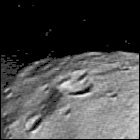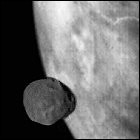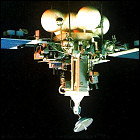Phobos 2 and the curse of Mars
 The Soviet Union loses all contact with the unmanned Mars probe Phobos 2 during a close flyby of the inner Martian moon Phobos, where the vehicle had been programmed to deposit a pair of surface landers. Unable to reacquire communications with Phobos 2, Soviet ground controllers later discover a fatal error in the programming of the probe’s on-board computer, leading to a loss of attitude control similar to the incident that doomed Phobos 1 in 1988. Since delivery of the landers never occurs, the mission is deemed a failure.
The Soviet Union loses all contact with the unmanned Mars probe Phobos 2 during a close flyby of the inner Martian moon Phobos, where the vehicle had been programmed to deposit a pair of surface landers. Unable to reacquire communications with Phobos 2, Soviet ground controllers later discover a fatal error in the programming of the probe’s on-board computer, leading to a loss of attitude control similar to the incident that doomed Phobos 1 in 1988. Since delivery of the landers never occurs, the mission is deemed a failure.
Phobos 2 arrives at Mars
 The Soviet Union’s unmanned Mars probe Phobos 2 successfully arrives in orbit around the red planet after over half a year of interplanetary travel (and after the loss of its identical twin, Phobos 1). Phobos 2 begins taking pictures of both Mars and Phobos and begins a series of orbital maneuvers that will eventually lead it to a very close approach to Phobos, where it is expected to release a pair of surface landers, the first of their kind to study a Martian moon.
The Soviet Union’s unmanned Mars probe Phobos 2 successfully arrives in orbit around the red planet after over half a year of interplanetary travel (and after the loss of its identical twin, Phobos 1). Phobos 2 begins taking pictures of both Mars and Phobos and begins a series of orbital maneuvers that will eventually lead it to a very close approach to Phobos, where it is expected to release a pair of surface landers, the first of their kind to study a Martian moon.
Phobos 1 and the curse of Mars
 The Soviet Union loses contact with the Phobos 1 unmanned Mars probe during its interplanetary flight and is unable to re-establish contact. The cause of the vehicle’s loss is later traced to a typo in a single line of command code uplinked to its computer from the ground; this error changes a routine command to a command to shut down attitude control, leaving Phobos 1 tumbling through space, unable to point its antenna toward Earth. The mission is a complete loss.
The Soviet Union loses contact with the Phobos 1 unmanned Mars probe during its interplanetary flight and is unable to re-establish contact. The cause of the vehicle’s loss is later traced to a typo in a single line of command code uplinked to its computer from the ground; this error changes a routine command to a command to shut down attitude control, leaving Phobos 1 tumbling through space, unable to point its antenna toward Earth. The mission is a complete loss.
Phobos 2 launched
 The Soviet Union launches the second of two unmanned Phobos space probes, designed to investigate the largest of Mars’ two asteroid-like moons and deliver a lander to analyze that moon’s surface. The Phobos program is intended to be the definitive Mars exploration program of the 1980s, as well as the debut of a new Soviet interplanetary vehicle to take over from the Zond/Venera design in use since the 1960s; only Phobos 2 will actually reach its target intact, but it will still fail to complete all of its mission objectives.
The Soviet Union launches the second of two unmanned Phobos space probes, designed to investigate the largest of Mars’ two asteroid-like moons and deliver a lander to analyze that moon’s surface. The Phobos program is intended to be the definitive Mars exploration program of the 1980s, as well as the debut of a new Soviet interplanetary vehicle to take over from the Zond/Venera design in use since the 1960s; only Phobos 2 will actually reach its target intact, but it will still fail to complete all of its mission objectives.
Phobos 1 launched
 The Soviet Union launches the first of two unmanned Phobos space probes, designed to investigate the largest of Mars’ two asteroid-like moons and deliver a lander to analyze that moon’s surface. With multiple nations pitching in resources to help the mission succeed, including the United States, the Phobos program is intended to be the definitive Mars exploration program of the 1980s, as well as the debut of a new Soviet interplanetary vehicle to take over from the Zond/Venera design in use since the 1960s.
The Soviet Union launches the first of two unmanned Phobos space probes, designed to investigate the largest of Mars’ two asteroid-like moons and deliver a lander to analyze that moon’s surface. With multiple nations pitching in resources to help the mission succeed, including the United States, the Phobos program is intended to be the definitive Mars exploration program of the 1980s, as well as the debut of a new Soviet interplanetary vehicle to take over from the Zond/Venera design in use since the 1960s.